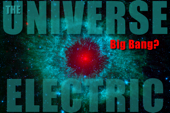Is it Appropriate to Speak of Electric Currents in Space?
01/30/08
One of the most common things I tend to hear while discussing the concept of electrical interactions in the ultrathin plasma of interplanetary, interstellar and intergalactic space is the rather simple question of whether it is even appropriate to use the phrase "electric current" at all.
I’ve even had one gentleman go so far as to tell me that the term "electric current" was inappropriate due to the fact that that term was commonly used to refer only to currents in wires and that currents anywhere else should simply be referred to as "currents" rather than "electric currents."
To be frank I was a bit flustered by this assertion. I wasn’t aware that there were different "flavors" of current, and I was equally unsure why someone would think that it matters where current flows. Is one kind of current significantly different from another, or are all currents created equal? Was he simply trying to shoot down my argument(s) through a trick of language? Such reasoning might be considered devious. If one removes the word "electric," does it make the entity described any less "electrical?"
I decided to do a bit of reading on my own time to see if his argument held water. In my various readings, I came across many terms that were new to me. I’m not an electrical engineer, but if things are explained simply enough, I can generally "get it." So, I decided to see if I could riddle out "electric currents" on my own.
General definitions of two forms of "current."
The first question to investigate was the assertion that electric currents go by different names in different materials, specifically "electric current" in wires and "current" in everything else.
Wikipedia had the following to say about "electric currents:"
Electric Current is the flow (movement) of electric charge.
So far so good. Electric current is the flow of electric charge. So, what is electric charge? Wikipedia had the following to say on that point:
The SI unit for quantity of electricity or electric charge is the coulomb, which represents approximately 6.24 × 1018 elementary charges (the charge on a single electron or proton).
What, then, is an elementary charge? The Wikipedia elementary charge article had this to say:
The elementary charge […] is the electric charge carried by a single proton, or equivalently, the negative of the electric charge carried by a single electron.
So, the coulomb (or unit of electric charge) is equivalent to about 6.24 quintillion elementary charges (each elementary charge being carried either by an single [negative] electron or [positive] proton).
The electric current article continues on to say:
The amount of electric current (measured in amperes) through some surface, e.g., a section through a copper conductor, is defined as the amount of electric charge (measured in coulombs) flowing through that surface over time.
[…]
The ampere, the measure of electric current, is an SI base unit so that the coulomb, the measure of electric charge, is derived from the definition of the ampere.
So, it seems that an electric current is defined in terms of the quantity of elementary charges flowing through some fixed "surface" (or a fixed cross-sectional area through conductor) over a given interval of time.
That means that one could take an arbitrary object such as a pipe or a copper wire and cross section it (cut it perpendicular to the direction of current flow). The 2-dimensional area (the flat circle defined by the plane of the incision) inside the object serves as the "surface" (or cross-sectional area). An electric current is the flow of elementary charges (attached to elementary particles such as the electron and proton) through that cross sectional surface over time.
The definition of "electric current" does not appear to include any reference to a specific material being necessary in order to be considered an electric current. In fact, one might argue that such a definition would be less useful as it would restrict our ability to measure current to only certain materials or situations.
The fact that particular materials are not specified in the definition of an "electric current" is actually a good thing. It means that as long as we can define a specific cross-sectional area and use that same area as a standard reference frame, we can measure "electric current" in anything we can physically access to acquire the measurements from. That includes such insulating (minimally- or non-conductive) materials as wood, glass, certain kinds of rock, and such conductive materials as metals, salt water, plasma, semi-conductors, etc. The flexibility of the definition of "electric current" is one of its greatest scientific assets.
Wikipedia had the following to say of the term "current" on its own:
A current, in a river or stream, is the flow of water influenced by gravity as the water moves downhill to reduce its potential energy. […]
Air currents may be caused by differences in temperature, pressure, or impurity concentration. […]
It appears that the term "current," by itself, applies strictly to the mechanics of wind and water, without reference to the workings of electricity and/or magnetism. This seems a wholly inappropriate terms when speaking of things electrical. As electrical engineer Don Scott has pointed out:
The charges moving in the wire going to your coffee maker do not respond to gravity; you do not have to place the coffeemaker lower than the wall outlet into which it is connected in order for the charges to flow down into it.
Surely a commentator could not suggest replacing reality with something as absurd as the example given by Scott above. As he says, charged particles in an electric current have no need of gravitational potential to get them where they need to go (moving up hill is equally as easy as moving down hill when particles are part of an electric current moving in response to a voltage potential). In fact, charged particles in an electric current can do things not possible if only gravitation were affecting them.
It is unfathomable to speak of electric currents by divorcing them from the very thing that defines them: flows of elementary electric charges.
If the intent of the change in terminology from "electric currents" to just "currents" is to divorce the word electric from the word current in order to avoid having to come to terms with electric currents (specifically, entities or processes that fit the definition of an electric current but which have to date not been described / treated as such) in space, and to deny the role of electrostatic and/or electrodynamic forces, then the change in terminology can only be a disingenuous diversion from the issue at hand and must stop forthwith.
If, however, the difference in terminology is due to some informal convention (while still recognizing the electrical nature of the interaction), I believe that we can simply agree to call a thing what it is, for the sake of discussion and for the sake of clarity. If the current is an "electric current" (a flow of electrically charged particles and/or elementary charges of the same sign in the same direction through a conductive medium, which can be measured over a finite surface or cross-sectional area) then let us call it such and not mince words over the issue. Let us also not confuse the issue by calling the same thing by multiple names, especially where one is better suited for the world of fluid and gas mechanics than for the world of electricity and plasma.
Taking the above into consideration, it does in fact appear that speaking of "electric currents in space" is appropriate where we talk about entities, events and processes that fit the definition (a flow of charged particles of like charge in the same approximate direction).
However, that’s not the complete story. The Wikipedia electric charge article elaborates:
The most common charge carriers are the positively charged proton and the negatively charged electron. The movement of any of these charged particles constitutes an electric current. In many situations, it suffices to speak of the conventional current without regard to whether it is carried by positive charges moving in the direction of the conventional current and/or by negative charges moving in the opposite direction. This macroscopic viewpoint is an approximation that simplifies electromagnetic concepts and calculations.
To make a rather long story short, conventional current refers (by convention, hence the name) to the flow direction of positive charges (generally carried by protons or ionized atomic nuclei that have had one or more [negative] electrons stripped away). However, there can be at least 3 kind of electric current.
-
A flow of strictly protons (or ionized, positively charged nuclei) or a "conventional current."
-
A flow of strictly electrons or an "electron current." The direction of the electron current is considered by convention to be the opposite of the direction of the "conventional current." A flow of negatively charged atoms that have received excess electrons may also fit this description insofar as it is the overall charge on an object or group that we’re concerned with (though it might not be called an "electron current" in that event).
-
A flow of both positively charged materials (protons or ionized positively charged nuclei) one way and a flow of negatively charged materials (electrons or negatively charged atoms that have received one or more excess electrons) in the opposite direction at the same time.
If we see any events, objects or processes fitting one of the three above criteria, we should consider them to fit the description of an electric current (or a flow of charged particles). In that case, the terminology of wind and water should be abandoned in favor of more accurate electrical terminology.
Unfortunately, it seems that much of current astrophysical theory is rooted in terminology not of this era. Scientists still talk of "winds" and "rains" of charged particles, excluding phraseology that implies any kind of electrical interaction. To deny that these processes fit the very definition of an electric current is not especially useful, especially when couching the questions in the wrong language leads to misunderstanding and "mysteries," "anomalies," etc.
In addition to being vigilant about calling flows of charged particles "electric currents" and treating them appropriately thereafter, it is also necessary to be vigilant about the relationship of electric currents, electric fields and magnetic fields (or, rather, the electromagnetic field).
It seems that modern science (at least in the field of astrophysics, if not others) has not been paying attention to its roots. Specifically, James Clerk Maxwell’s work should be revisited by those in the astrophysical sciences.
Wikipedia shares the following short snippet (plucked from amongst a lengthier article):
The greatest work of Maxwell's life was devoted to electricity. Maxwell's most important contribution was the extension and mathematical formulation of earlier work on electricity and magnetism by Michael Faraday, André-Marie Ampčre, and others into a linked set of differential equations (originally, 20 equations in 20 variables, later re-expressed in quaternion- and vector-based notations). These equations, which are now collectively known as Maxwell's equations (or occasionally, "Maxwell's Wonderful Equations"), were first presented to the Royal Society in 1864, and together describe the behaviour and relation between electric and magnetic fields, as well as their interactions with matter.
In short, Maxwell’s Wonderful Equations (so colorfully named) integrated our understanding of magnetic fields with our understanding of electric fields and our understanding of electric currents. Wikipedia’s electromagnetic field article is helpful:
The electromagnetic field is a physical field produced by electrically charged objects. It affects the behaviour of charged objects in the vicinity of the field.
[…]
The field can be viewed as the combination of an electric field and a magnetic field. The electric field is produced by stationary charges, and the magnetic field by moving charges (currents); these two are often described as the sources of the field. The way in which charges and currents interact with the electromagnetic field is described by Maxwell's equations and the Lorentz Force Law.
Electric charges and electric fields, electric currents and magnetic fields are thus all interrelated (flip sides of the same coin(s), all stemming from electric charges and/or their motions). Stationary electric charges spawn the electric field, whereas moving electric charges spawn the magnetic field.
What does it all mean? To cut to the chase, a dynamic magnetic field cannot be sustained without the net motion of charge carriers (electrons and/or protons), otherwise known as (you guessed it) an electric current. Game, set, match. Where we see dynamic magnetic fields being generated, we must consider the source: electric currents.
The space age has seen an explosion of data beamed back from space. The wealth of data at our fingertips is nothing short of amazing. Even more amazing is that everywhere we look we see dynamic magnetic fields. Earth has one. So do Saturn, Jupiter and the sun. Likewise entire galaxies. And yet, many in the field of astronomy and/or astrophysics appear to make no reference to electric fields, or flows of electric current when discussing these features. When challenged on the issue, they simply wave off and mutter something to the effect that "electric currents can’t exist in space" or "even if they do, they don’t do anything." Astronomers and astrophysicists appear to conjecture incorrectly that the magnetic fields themselves are the prime movers and shakers, a whole and complete entity divorced from any other interactions. From the standpoint of Maxwell’s Wonderful Equations, that standpoint is patently absurd.
Astronomers’ insistence upon an electrically neutral, electrically sterile universe is rooted in a prior age and based upon assumptions that became locked into the halls of academe before the term plasma had even been coined with respect to ionized materials, an era before the computer age and before space probes invalidated many previously sacrosanct notions about the universe.
Astronomers must sit up and take notice of not merely the magnetic fields that are seen ubiquitously in interplanetary, interstellar and intergalactic space, but they must also revisit Maxwell’s equations and their implications. They must recognize the electric currents that inherently drive the magnetic fields. This is non-negotiable if astrophysics is to proceed with any hope of making sense of the universe.
It is highly recommended that the seminal works of James Clerk Maxwell, Kristian Birkeland, Hannes Alfven, and Irving Langmuir should be required reading for astronomers wishing to gain an understanding of what is going on on our planet, in our local space and out in the universe at large.
However, we need not wait until we can reach other stars in our galaxy or until we can physically sample stars from other galaxies, in order to gain significant insight into astrophysical processes. Coincidentally we have a star right in our own back yard. Or, more aptly, in what we perceive to be our sky. It’s commonly referred to as the sun.
Taking the prior definitions of electric currents along with the definition of the electromagnetic field (tying together electric charges, electric fields, electric currents and magnetic field), I can already suggest a number of local entities and/or processes that require immediate attention from an electrical perspective.
-
Proton beams in the solar wind (a "conventional current").
-
Electron beams in the solar wind, sometimes called "strahl" (an "electron current"; which ever way the electrons drift, "conventional current" points the opposite direction).
-
"Flux tubes" in the solar wind (tube-like "magnetic structures" in the solar wind). These may be "Birkeland currents" (named after the famous Norwegian physicist Kristian Birkeland, who empirically studied the auroras, performed controlled laboratory experiments and accurately predicted rope-like electrified filaments emanating from the sun, and whom I previously mentiond he should be required reading for astronomers, and probably solar physicists.
-
"Magnetic flux ropes" entering the Earth’s atmosphere and pointing back toward the sun (physicists seemed surprised to find these just recently, despite Birkeland’s predictions in the early 1900’s and subsequent verification in the 1960’s and 1970’s; one wonders how long it take for a verified prediction to register with the scientific community). Again, these are "Birkeland currents" despite the misleading terminology.
Conclusion:
Only the tip of the iceberg has surfaced in this seminal Thunderblog post. Once we have gotten past the definition of electric currents and begin to identify electric currents and circuits with their magnetic fields in space, we can begin to unravel some of the tangled threads of mystery and begin to weave a newer, better, brighter and more sensible tapestry that all can see, understand and enjoy equally.
Once we can recognize such distant cousins as lightning and solar prominences as part of the same linked family of electrical processes, and see things as they truly are, entire new vistas in the sciences will open up before us. The solar system, let alone the galaxy may become more meaningful and familiar.
By re-evaluating certain key assumptions that no longer stand up to scrutiny (dynamic magnetic fields cannot exist divorced from dynamic electric currents, an electrically sterile / neutral universe has never been proven, space as a complete and perfect vacuum was invalidated by the discovery of electrically charged plasma nearly everywhere in space), we can tread new paths that promise to unlock the secrets of the way things TRULY work "out there."
For more info, see:
Current density
Charge carrier density
Charge carrier
Charge density
Articles About Electricity
Electrical Engineering Dictionary
The Norwegian aurora polaris expedition, 1902-1903 (1908-)
Disclaimer: quotes from web sites referenced in the course of this Thunderblog post were current as of the date of publication, but are subject to change at the whims of those sites’ administrators (especially Wikipedia).
Permalink to this article.
Public comment may be made on this article on the
Thunderbolts Forum/Thunderblogs (free membership required).
|

Michael Gmirkin is a technology enthusiast with a keen interest
in exploring the electrical nature of the universe.
My Archives
Chronological Archives
Archives by Author
Archives by Subject
Thunderblogs home
|




